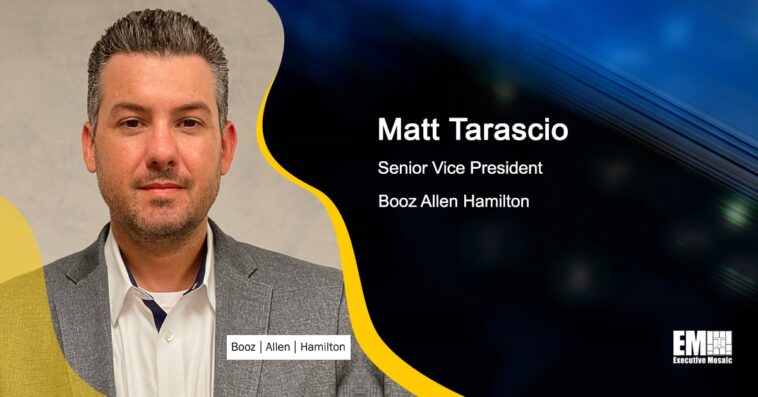Matt Tarascio has navigated a long, unexpected journey to reach his current position as senior vice president at Booz Allen Hamilton. For two decades, Tarascio worked at Lockheed Martin (incl. Sikorsky) and he was convinced that the future of his career lay in the design of advanced aircraft. The executive was even a crucial part of the team responsible for designing the world’s fastest helicopter (which is now on display at the Steven F. Udvar Hazy National Air and Space Museum). When a VP asked that he take the reins of the team overseeing health management, prognostics and analytics, he was hesitant to relinquish his dream of aircraft design.
Soon enough, however, Tarascio became fascinated with all things data, analytics and AI and was named Lockheed’s first chief data and analytics officer. Upon leaving Lockheed Martin, he joined Booz Allen to focus on the development of artificial intelligence for the U.S. Department of Defense.
In this Executive Spotlight interview, Tarascio engaged in a conversation that touches on trends in business development, the qualities that help a company retain talent and the necessity of the Pentagon’s formation of the Chief Digital and Artificial Intelligence Office earlier this year.
How have recent partnerships been able to assist your company expand its position in the federal marketplace, drive innovation and new capabilities and ultimately help complete your company’s mission?
What springs immediately to mind is Booz Allen Ventures, LLC, a $100 million corporate venture capital arm we recently established. We look for companies that have groundbreaking tech that can help us develop solutions to our customers’ toughest problems. A great example of this is our investment in Latent AI, who are helping us optimize algorithms for deployment to edge devices.
One of the big challenges I’ve found when partnering with smaller companies is that it’s easy to make a splash by doing a public announcement, but you have to be willing to dedicate time and energy to work with them in order to extract value from the partnership. It sounds easy but it can be extremely challenging. We need to help smaller companies understand where their technology can fill an important gap or need for the customer and work with them to integrate that into a joint solution.
Our customers shouldn’t care whose name is on a solution, if it works as intended and solves a critical need, it really shouldn’t matter. In order to provide the best solution to our customers we have to streamline our partnering processes to seamlessly integrate technology and in doing so reduce the friction of working with smaller companies. And again, that’s easy to say but difficult to do.
I’m very fortunate to have a team that works tirelessly with smaller companies to understand what they’ve got and then integrate it into larger solutions. I think a common mistake that bigger companies tend to make is that they go for the splash, ‘Hey, we just invested in this company,’ and then 12 months later, no one from the company has talked with them. Unfortunately, I’ve seen this happen multiple times, which creates frustration with the small company, which in turn reduces the value of the relationship.
I’m a big believer in quality over quantity—pick a few smaller companies that you’re willing to invest time and energy in versus trying to make a big splash with lots of companies.
How does your company ensure long term success for your workforce to drive value for your employees as you continue to face the uphill challenge to recruit and retain the best talent in the federal marketplace?
This is a question all companies are faced with. Particularly in the fields of data science and artificial intelligence, which have been the focus of numerous recent studies, surveys and assessments. We’re all competing for the same relatively small group of critical talent, but there are a couple of things which I think Booz Allen does extremely well.
First and foremost, I think the key to both retaining and recruiting talent is to ensure that the work we do has an impact. When you develop solutions for the DOD (the customer I focus on) there’s a clear impact. If you consider what’s going on around the world today, it’s easy to make a connection between the work we do and the important impact that we have. Many of the solutions we provide directly affect the security of our nation – that’s a big motivator for our team. So, I think one of the big selling points for companies like Booz Allen is that you can have a significant impact on the future. And if you’ve got children, you can be part of securing their future and making the world a safer place. That’s something that has always resonated with me throughout my career: the importance of the mission.
The other thing that we do extremely well is training. There is simply not enough well-trained talent in data science and AI to fulfil our needs, so it’s vital to have a robust internal curriculum that combines original home-grown content with the best that commercial training companies have to offer. This allows people with an interest in AI to upskill at the company, which is a key part of retaining talent and providing opportunities for future growth.
I also think company culture is incredibly important to talent retention and attraction. I recently attended a function on behalf of the company for CARE [the organization that gives support to help fight world hunger]. It is such a great cause and when the company that you work for is committed to supporting organizations like this, it gives you a sense of pride about being part of that company.
We often discuss innovation from the technical or capability side. What are some of the unique challenges that you’ve seen on the business side of innovation that haven’t been addressed or discussed enough?
It may seem strange to say but the thing that a lot of companies actually do well is innovate on the technology. If you don’t innovate on the business side however then you can’t get that tech into the hands of the customer, and ultimately, it doesn’t matter how good the tech is if you can’t get it over the valley of death. Business innovation comes down to delivering value to your customers in novel and unique ways to ensure that they can leverage the technology as rapidly as possible. In order to truly innovate, you need some people that have a business development background that can think outside the box, the same way you need people with a tech background that can think outside the box. That skillset is hard to find on the business side, partly because we are a highly regulated business and partly because it involves embracing some level of business risk (as opposed to tech risk). Being able to deliver through different types of mechanisms can be challenging, but we continue to explore options.
Take software. A common approach to selling software is licensing, but is that really what is best for the customer? To answer that question, you really must understand what your customer wants or needs and how their budgets work. Licensing based on seats, for example, simply may not work long term for a customer. So, you’ve got to be flexible with how you propose delivering software in order to deliver value. I think that’s a place where we can work closely with our customers, to understand what it is that they really can do, are willing to do, want to do and then come up with unique approaches of how to do that. I don’t think the answer is always one approach, such as licensing, but rather a tailored approach that meets the unique needs of specific customers.Given your deep involvement with delivering AI technology to DOD customers, what has been your response to the fairly recent creation of the Chief Digital and Artificial Intelligence Office? How has that impacted your work or how you do business?
It was an extremely important move to align these critical functions together under the CDAO umbrella. When General Shanahan started the JAIC after leading Project Maven, it made a lot of sense. He was out ahead of the curve on AI and trying to do as much as possible to grow our strategic tech advantage. But the formation of the CDAO is what’s required now. For our nation to be able to tackle problems of the magnitude of JADC2, you must have a lead organization in front of it. A recent article I read highlighted the need to define the JADC2 problem better, but you can’t do that if no one truly owns it.
It’s important to have the CDAO out in front of large challenges like JADC2. It’s always a challenge when you’re a centralized organization with lots of different competing needs from different stakeholders. But you really do need a central organization to pull it all together and for joint missions, such as JADC2, I think it’s an absolute necessity. The leader that they found is outstanding, and I think he’s the right person at the right time to take this organization to where it needs to go. I think he’s going to do an amazing job and we are going to do everything we can to support the CDAO in this vitally important mission for our nation.





